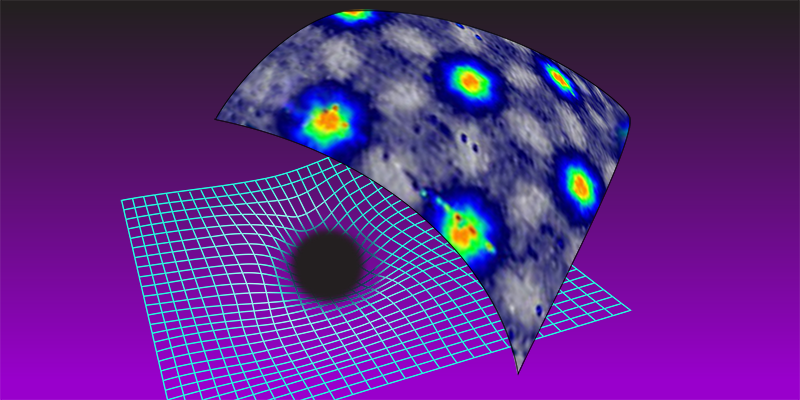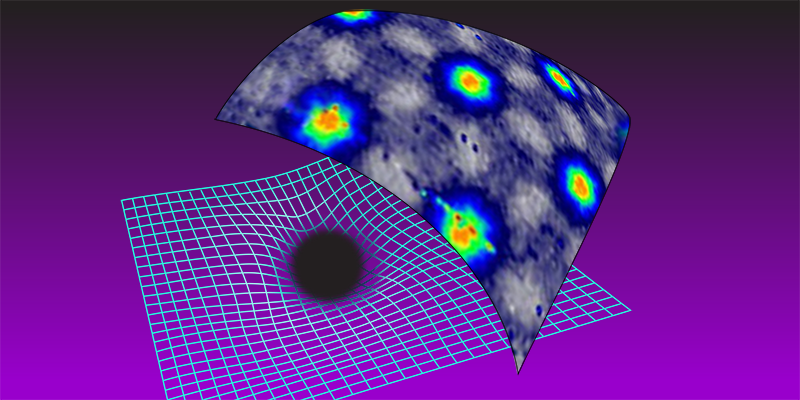Holographist by Trade
One of the jibes against string theory has been that it can’t be verified, since the energy level where “stringiness” should appear is far beyond experimental capability. However, researchers have found that certain mathematical solutions in string theory can be applied to relatively low-energy problems in many-body physics. This so-called holographic correspondence has provided insights into superconductors, hydrodynamics, and chaos. From this success, a new field has emerged in which holographists use models of black holes to uncover new relationships in the matter around us.
Holography is a bridge between strings and strongly interacting systems. String theorists have crossed this bridge into a wide range of different fields. But some holographists are taking the bridge in a different direction. They are starting from a condensed-matter perspective and using string theory tools to form models of quantum many-body systems. This approach was the focus of the recent Holomatter conference at the Institute of Theoretical Physics (IFT) in Madrid. The meeting, which was cut short because of COVID-19 related shutdowns, brought together string theorists and condensed-matter researchers to discuss where their particular problems might converge. One of the goals of the conference, according to the IFT’s Matteo Baggioli, was to bring attention to the community of holographists “living in the middle” between string theory and condensed matter.
The history of holography started in 1997 with an arxiv paper by Juan Maldacena—now at the Institute of Advanced Studies in New Jersey—where a connection was made between a string model in an empty universe, called anti-de Sitter (AdS) space, and a quantum theory of a particle-filled world, called conformal field theory (CFT). The connection is based on the CFT world being a lower-dimensional projection, or hologram, of the AdS universe. Although abstract, the AdS/CFT correspondence has real-world consequences in that one can solve problems in AdS—where there’s gravity and black holes, but no particles to worry about—and apply the answer to the messy interactions that animate quantum many-body problems.
One of the first places that the AdS/CFT correspondence found success was in nuclear physics, specifically in a 2001 prediction for the viscosity of the quark-gluon plasma. Shortly after, several groups began applying AdS/CFT to condensed matter. Holographists found that the region around a black hole could be mapped—under the right boundary conditions—to a strongly correlated quantum system. For example, black holes with excitations, or “hair,” on their surface can go through a phase transition that resembles the onset of superconductivity. More recently, some holographists have been looking into other connections with chaos and hydrodynamics. “Like any fertile field, holography has not stood still for any of the 20-plus years it’s been around,” says Sean Hartnoll from Stanford University in California.
It might seem crazy that holography works at all. Why should the physics of a black hole, for example, tell us anything about a phase transition in a metal or the growth of turbulence in a fluid? Hartnoll explains that holography is a methodology for obtaining a coarse-grained picture—or effective field theory—of a complex microscopic world. A similar approach is hydrodynamics, which looks past the individual motions of molecules in a liquid and instead characterizes their collective behavior with a velocity field. In holography, the gravitational equations—specifically Einstein’s equations—provide a fluid-like description of matter, while glossing over the microscopic details (see Focus: Gravitational Theory Reproduces Superconducting Circuitry).
Holography is not the only route to an effective field theory in condensed matter, but in some cases it’s the only one that scientists can compute, says Blaise Goutéraux from the École Polytechnique in France. “Einstein’s equations are comparatively easier to solve than the original condensed-matter equations,” he says. By solving the gravity side of the AdS/CFT correspondence, a holographist may get lucky and find something unexpected, like a new relation or symmetry. Goutéraux says that the next step is to pull out the “holographic dictionary” and translate that finding into the language of condensed matter. A recent example of this process relates to dissipation. Holographists showed that black holes dissipate energy at a certain rate that appears to match the dissipation in so-called strange metals (see Viewpoint: Graphene Reveals Its Strange Side). They are now trying to see if there exists a universal form of dissipation that might give new insights into high-temperature superconductivity.
But the holographic dictionary is still a work in progress, with many translations yet to be worked out. “The low-lying fruit has been picked.” says Jan Zaanen from Leiden University, Netherlands. To do holography now, one has to know more about condensed-matter physics, he says. Goutéraux agrees. “Condensed matter is very rich, with lots of messy effects from atomic and electronic interactions,” he says. Holography can’t be applied to each specific case in condensed matter. “One needs to disentangle system-specific effects from more generic effects,” Goutéraux says.
To identify the more universal questions, holographists are increasingly spending time in condensed-matter circles. “There are new generations of holographists who tend to know much more about condensed matter than past generations of people who worked on string theory or holography,” says Hong Liu, from the Massachusetts Institute of Technology, Cambridge. On the flip side, this new generation is getting by with less string theory expertise, Baggioli says. “The original AdS/CFT model was based on a very particular string theory setup,” he says. “But now, in my community, the models we use are closer to classical gravity than the quantum gravity of strings.”
Zaanen says that holography is in a transition period. “Holographists are very different from the original string theorists,” he says. In his mind, the pure string theorists have moved onto other problems, such as quantum information, and have left holography to the more condensed-matter minded researchers. However, Hartnoll has a different take. He likens holography to a building with many rooms that are connected to each other. For a while, a lot of people were crowded into the condensed-matter room and now they’ve moved to other rooms. “But it’s the same building,” Hartnoll says.
–Michael Schirber
Michael Schirber is a Corresponding Editor for Physics based in Lyon, France.





